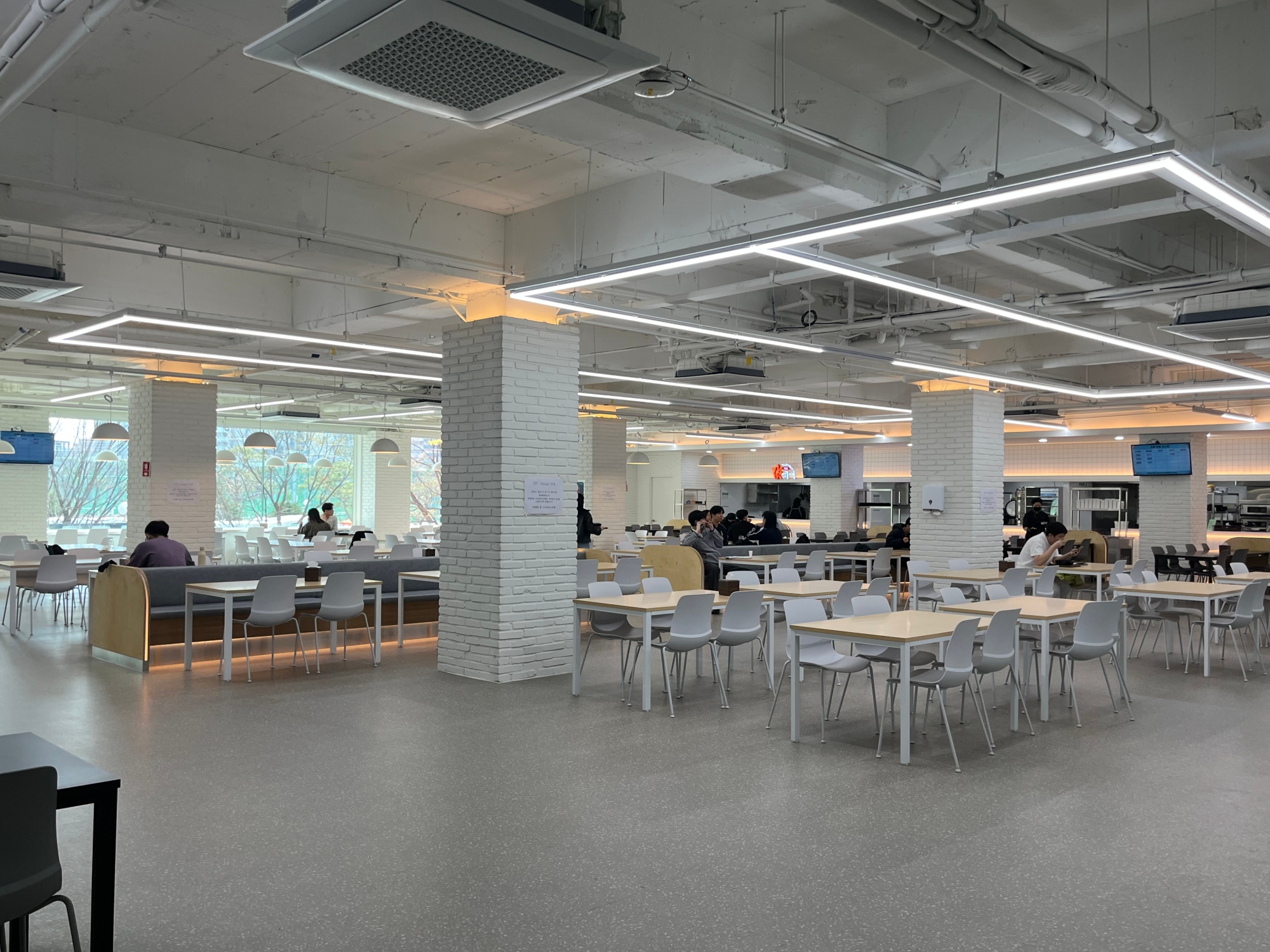
 The new cafeteria in Student Union Bldg.2
The new cafeteria in Student Union Bldg.2
For the Spring 2025 semester, there were two significant changes in SeoulTech’s cafeterias: the first was the cafeteria in Student Union Bldg.2 becoming a food court like the cafeteria in Student Union Bldg, and the second was that the 1,000 won breakfast menu changed. However, these changes were met with negative responses from students, with some complaining about the new 1,000 won breakfast and Student Union Bldg.2’s cafeteria. This led SeoulTech to conduct surveys and briefings in order to gather students’ opinions. The SeoulTech investigated the situation from the students’ point of view.
Multiple Complaints About Student Union Bldg.2’s Cafeteria
There are complaints from students about Student Union Bldg.2’s cafeteria. The most common feedback concerns high pricing, a lack of seating for people sitting alone, long waiting times, and the food itself. First, it costs ₩5,900 for jajangmyeon (black soybean paste noodles) and ₩6,500 for usamgyeop soondubu-jjigae (beef loin soft tofu stew), which is not much different from restaurants outside the university (₩7000 for jajangmyeon and ₩8,000 for usamgyeop soondubu-jjigae). Some might argue that it is still cheaper than buying outside, but students point out that unlike restaurants outside the cafeteria does not offer complimentary side dishes, meaning the cafeteria has virtually no price difference from restaurants outside the university.
The second point is the lack of single-seats. Most of the seats in the Student Union Bldg.2’s cafeteria are table seats (seats for four people or more). When a reporter from The SeoulTech visited and counted the seats, there were about 20 single-seats by the window, and the rest were table seats. The lack of single-seats makes students who eat by themselves eat at the larger tables, resulting in bigger groups having to wait for tables to come available. In addition, slow service contributes to the lack of seats. When The SeoulTech’s reporters ordered food, it took 11 minutes for jajangmyeon and 25 minutes for stir-fried pork belly with rice respectively. This deters students who have to eat and go back to classes within an hour. This issue was reported by a significant number of students. The fourth criticism was about the food, particularly the Chinese food section. One respondent commented, “The fried rice is soggy because it comes from a frozen packet.” Another said, “Jajangmyeon is priced the same as in an authentic Chinese restaurant, but the quality is like regular food court standard.”
The Challenging History of the 1,000 Won Breakfast
The 1,000 won breakfast program was initiated by the Ministry of Agriculture, Food and Rural Affairs to provide affordable, nutritious meals for university students nationwide. The program, which started in 2017, grew in 2023, expanding to 29 out of 39 universities in Seoul. This expansion was driven by an increase in government subsidies, raising support from 1,000 won to 2,000 won per meal. SeoulTech, despite being a national university, initially opted not to participate, leading to frustration among the students.
In 2024, SeoulTech finally joined the program, but the rollout faced challenges. Students began queuing up 20 minutes before sales started, and non-students also took advantage of the affordable meals, which meant many students missed out despite waking up and traveling to campus early. To address these issues, breakfast coupons were introduced through the Payco app. Students could purchase these coupons only after verifying their student status via the app and could redeem them between 8AM and 10AM on weekdays. However, demand remained overwhelming, with coupons selling out almost instantly. This left many students disappointed as they frequently missed the opportunity to secure a coupon before they ran out.
Complaints Over the Menu
Last year, the cafeteria offered 70 rice bowls and 30 gukbaps each day, giving students two options to choose from. With the start of the Spring 2025 semester, SeoulTech aimed to expand access to the 1,000 won breakfast. To do so, the university reduced the menu from two options to one. This change allowed 30 additional students to receive breakfast each day. However, the changes made to the menu received a backlash from students. While most were satisfied with the rice bowls served on Mondays and Tuesdays, complaints arose about the menu served on Wednesdays, Thursdays, and Fridays. On those days, the menu consisted of plain rice, soup, and two side dishes—items that students felt were lacking in quality.
The new breakfast menus introduced this year are as follows:
- Wednesday: Kimchi stew, kimchi, stir-fried eomuk (fish cake), and rice
- Thursday: Doenjang-jjigae (soybean paste stew), kimchi, stir-fried pumpkin, and rice
- Friday: Bone soup, kimchi, kongjaban (soy-simmered black beans), and rice
In contrast, last year’s menus were much richer in protein and variety.
- Wednesday: Tuna mayonnaise over rice with a fried egg and soup, or boiled pork slices with rice soup
- Thursday: Stir-fried pork belly over rice with a fried egg and soup, or sundae (Korean blood sausage) with rice soup
- Friday: Soy sauce pork rice bowl with a fried egg and soup, or boiled pork slices with rice soup
Students’ reactions included, “The doenjang-jjigae has very little chunks in it,” “The bone soup has no chunks whatsoever,” and “The overall amount of rice is smaller, so it’s not filling enough.” Although students only pay ₩1,000 for breakfast, the total cost of making the food is ₩5,000. This amount is covered by ₩1,000 contributed by the student and ₩4,000 provided jointly by SeoulTech and the government. Students expect the quality of the food to match the ₩5,000 value. However, the general feeling is that the serving sizes are not satisfactory and that the quality has declined compared to last year. One user on the student community app, Everytime decided to take action and complained to the government about the 1,000 won breakfast, sharing the response he received. In turn, SeoulTech officially launched a survey and began accepting feedback from students until March 25. After the first round of feedback, SeoulTech launched another survey asking students whether they would prefer jangguk (clear soup boiled with soy sauce) instead of bean sprout soup on Monday and Tuesday. The survey also gathered opinions on the Wednesday to Friday menus—specifically, whether students would rather keep the current meals with additional side dishes or return to rice bowls, as offered last year. Among 176 respondents, 69.9% expressed a preference for jangguk over bean sprout soup. Similarly, out of 175 respondents, 78.9% favored rice bowls over the current menu. Based on these results, SeoulTech is preparing to update its menu to better reflect these preferences.
There are many complaints from the student’s point of view, but the university is trying to address the problems through continuous surveys and explanation sessions. Students hope that the criticism will transform the standard of SeoulTech’s cafeterias.
Reporters
Jinpyo Hong
undohere@seoultech.ac.kr
Myungjae Lee
swk08085@seoultech.ac.kr




 Comment 0
Comment 0 Posts containing profanity or personal attacks will be deleted
Posts containing profanity or personal attacks will be deleted